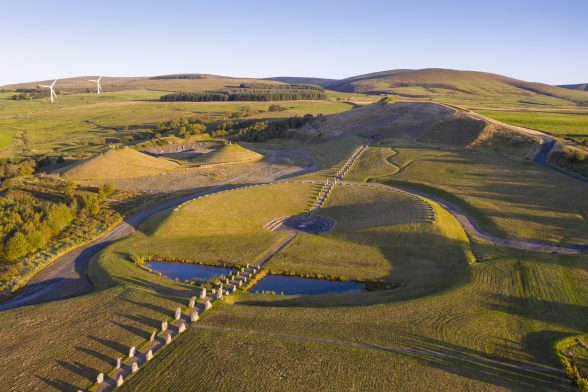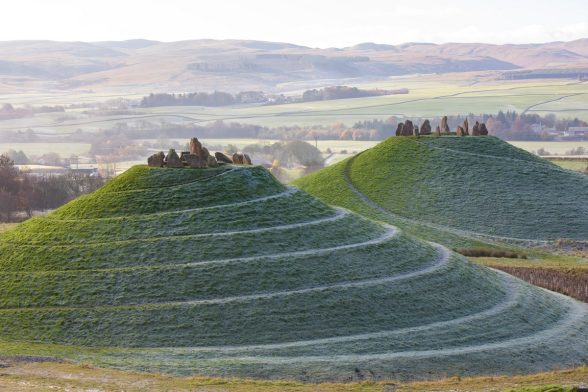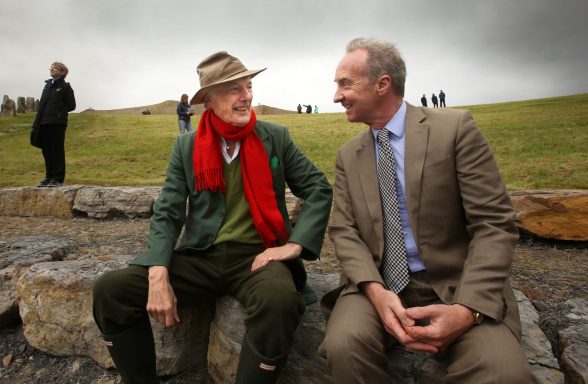This website uses cookies
This website uses cookies to enable it to function properly and to analyse how the website is used. Please click 'Close' to accept and continue using the website.



Image Credit: Mike Bolam for Crawick Multiverse
Crawick Multiverse in Dumfries and Galloway, Scotland, has become the UK’s first 21st Century designated landscape, having been completed just 7 years ago. It was designed and constructed on the site of a former open-cast coal mine by renowned landscape architect Charles Jencks between 2011 and 2017, and was to be his final land art project and largest work in the UK. It is now run by The Crawick Multiverse Trust, who operate the site as a visitor attraction, unique destination and outdoor venue.
Crawick Multiverse was nominated by members of the general public as part of Historic Environment Scotland’s ‘Designed Landscapes of the Recent Past’ initiative; identifying, recognising and celebrating Scotland’s modern garden and designed landscape heritage. The project focuses on sites dating from 1945 to the early 2000s in Scotland. When consulted C20 Society strongly supported the proposed designation; it becomes the first post-2000 listing or designation of any type in the country, and moves the debate around recognising Britain’s modern heritage firmly into the 21st century.

Image credit: Crawick Multiverse
Design
Covering an area of 22.5 hectares of land – over 36 football pitches – Crawick Multiverse is significant for its ambitious scale, visual and conceptual design integrity. Designed as a land regeneration project for public access, the Multiverse enriches the local community and connects its visitors to both the industrial history of the area and the prehistory of the British Isles.
Jencks envisaged Crawick Multiverse as a place to explore cosmology, prehistory, and connections to the past through the theory of the ‘multiverse’, with features in the landscape that convey a sense of the universe and its rhythms. Major features include:
The North-South Line is a 400-metre-long processional avenue through the middle of the site on the north-south axis, lined with standing stones which evoke prehistoric stone monuments like the Neolithic Calanais (or Callanish) Standing Stones on the Isle of Lewis, to the Omphalos of Ancient Greece, which signifies both the geological and mythical interior of the Earth. Among other things, they reflect Jencks’ interest in the ‘cultural continuity’ of stone circles, henges and other monumental landforms constructed over a 3500-year period in the British Isles.
The Sun Amphitheatre is a circular henge-like landform 90 metres in diameter, located at the centre of the Multiverse site, and dissected by the North-South Path. Designed to host public events and performances, it has grassed, sloping embankments radiating outwards from a central gravelled area. Embedded at the centre of the amphitheatre is a stylised ‘solar flare’ motif in the form of a mosaic, using specially selected river stones from the nearby River Nith. The motif (designed by Jencks in 2016) depicts the magnetic shield that protects the earth from the sun’s rays and solar winds, the effect of which can be seen in the night sky as the ‘aurora borealis’ or Northern Lights. The stones are arranged according to size, colour and type and are split to reveal and accentuate their unusual circular markings.
The spiral galaxies of Andromeda and The Milky Way are represented by two large mounds of earth at 25 and 15 metres high respectively. Both have spiral pathways leading to their summits, which feature spiralling arrangements of mudstone and red sandstone boulders and smaller stones representing the effect of black holes, space dust and other cosmological phenomena on the galaxies.

Image Credit: Mike Bolam for Crawick Multiverse
Charles Jencks (1936–2019) was a prominent cultural theorist, landscape designer, architectural historian and the co-founder of the Maggie’s Cancer Care Centres. Among the first to define Postmodernism as an overarching movement, his pluralistic views on architecture and culture can be charted through a run of more than 30 books, published and reprinted between 1972 and 2019. Born in America but resident in the UK for most of his adult life, Jencks began to focus on landscape art and garden design from the late 1980s onwards to further explore his ideas.
Other major Charles Jencks works

Image credit: Crawick Multiverse

Become a C20 member today and help save our modern design heritage.